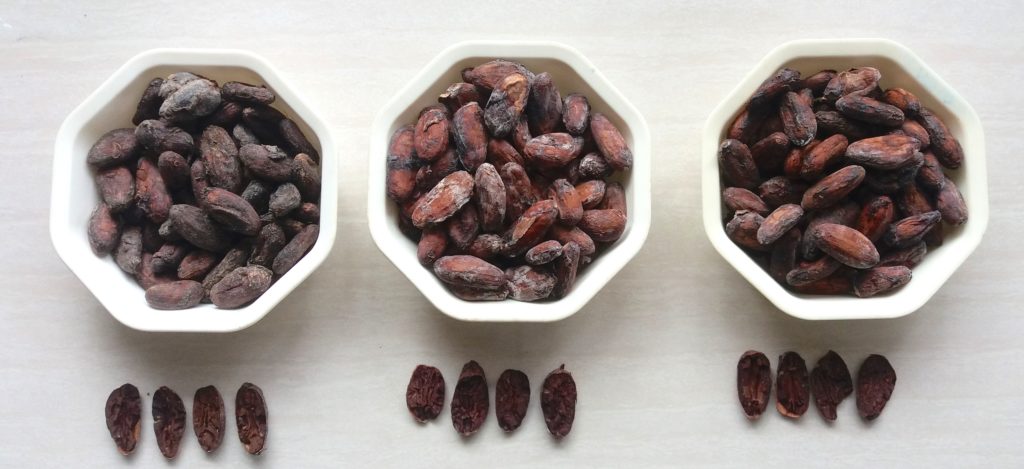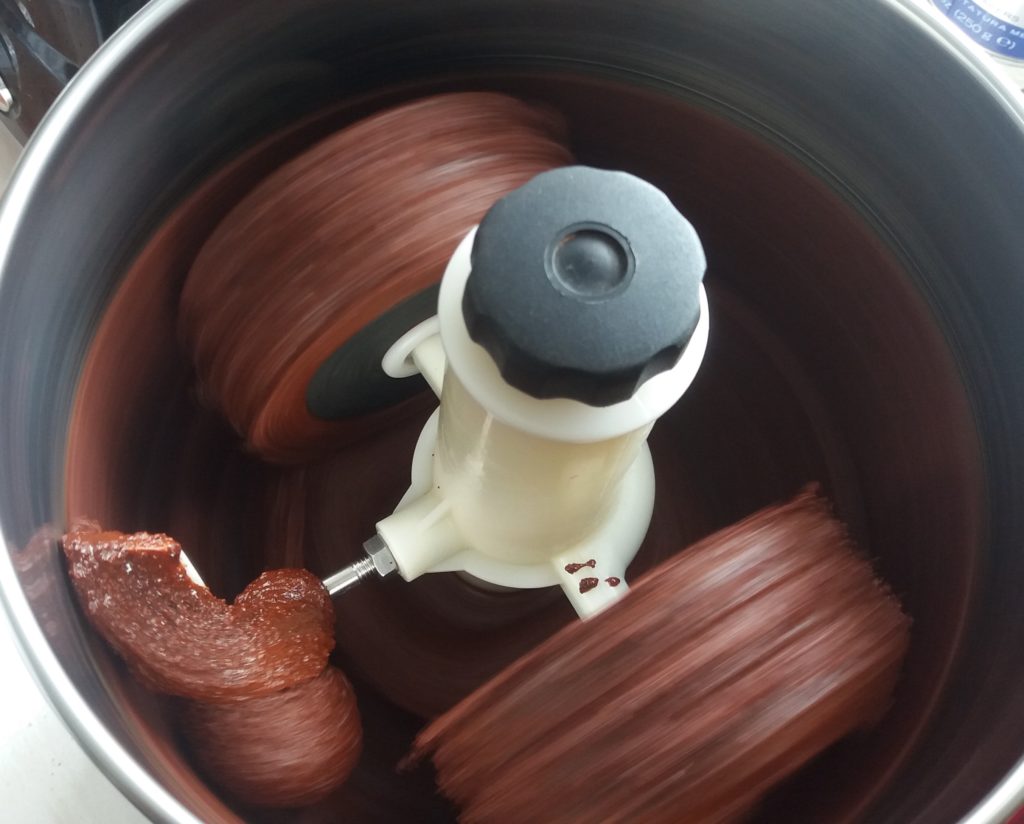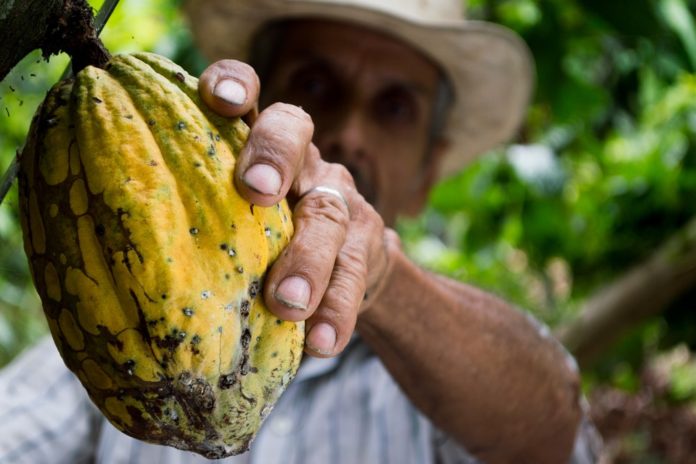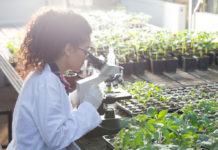According to Chloe Doutre-Roussel’s book The Chocolate Connoisseur, Aztec sacrifice victims who felt too melancholy to join in ritual dancing before their death were often given a gourd of chocolate (tinged with the blood of previous victims) to cheer them up.
Amanda Fiegl, Smithsonian.com
First, an emphatic announcement: We deserve chocolate. We deserve an intense, vaguely granular, bittersweet symphony of life melting on the tongue. We deserve every good thing we get from it because, dear Lord, how can anyone have thought something other than slime would be the end result of opening the first cocoa pod?
To do a cut test on a cocoa bean, make a clean vertical slice from top to bottom. It looks like a heart. It may bleed. (To be clear, and not make this sound more romantic than it is, it can also look like your kidneys or a part of the brain.) This is, to me, no surprise at all. Because making chocolate is such an exacting, exhausting, and nerve-wracking experience, surely some really important part of your body is going to start hemorrhaging.

But I only discovered this after I’ve had the best chocolate in my vast and rambling pursuit of the pleasures of the bean. The best chocolate is a 75 per cent dark un-tempered miracle. It’s also been made in a lab by a cocoa scientist who’s spent a dozen years or so working on ways to gauge—and maintain—quality standards for the great beans of Trinidad. This is a small lab, books from floor to ceiling, apparatus and equipment along the walls, a pristine white table in the middle for everything else. It’s for the quality testing work, but on the side it’s used for experiments with the dregs, the rejected, the doomed beans. Cocoa beans come here to get the treatment promised by the Statue of Liberty: Give me your tired, your poor, your huddled masses yearning to breathe free, the wretched refuse of your teeming shore, et cetera, et cetera.

The terrible truth is that until the beautiful cocoa pod becomes a well-packaged piece of chocolate, almost everything is rather gross. The researchers and farmers who have a care for the quality of the bean and the integrity of the process at all its mind-numbing stages are the true heroes. They are the mothers of profoundly ugly babies who sit there rocking their newborn monster, whispering to it of its beauty and promise.
The Lab: The First Frontier
This is the price of entry. I must sniff three sets of beans and describe what I detect. One set smells like dirt and smoke; one, like a musty book; one, vaguely like what I think chocolate smells like. It turns out that one is a bean gone bad. (This is the bean that got ignored, left to fend for itself and is likely to join a gang.) One is a good new bean. One is a good old bean. All the while I’m sniffing and trying to look thoughtful, my Lab God has a serene, blissful look on her face. She is delighted by the slight look of nausea that comes over me. She’s reading my reactions like the most sublime literature. She is also making tea out of paper-dry bean husk.
Grateful am I that I only have dried beans to contend with. I’ve seen what goes on before. Whether it’s wine, cheese or chocolate, always remember that when people speak rhapsodically about anything—anything at all, related to fermentation—please remember that they are the acolytes. We, the mere congregation, unschooled in transubstantiation, we think a thing is smelly. They know smelliness is next to godliness. Before you can have a dry bean, you have to have opened the pods and put the glop of pulp in which the beans are cocooned to ferment for around five or six days. After that, well, you put your cocoa out in the sun. Or, at any rate, in some place where it will be allowed to dry. What you end up with looks like a coffee bean you should have thrown away.

Processing the cocoa
So, here I sit with my surprisingly refreshing husk tea (or are they really pencil shavings?) that tastes exactly nothing like chocolate and the real work begins. “Sort,” Lab God instructs. She pours a goodly quantity of beans into a tray. We remove anything that does not look like a bean. Stems, dirt, “oh, that’s dried placenta!”, the odd leaf. Bewilderingly, a gypsum screw. “That!” Lab God exclaims, “That is how things get very bad.” It’s true. We’ve barely started and all could have been lost. At the very next stage, the roasting, we’d have ended up with a batch of beans with a deeply metallic flavor. Or, that plus a molted bit of metal. Not good for chocolate, ergo not good for me.
After roasting comes crushing. In this wild old-school world, we’re using a mortar and pestle. I like traditional kitchen aids as much as the next person but what I do not like is exercise. And this, friends, is starting to feel an awful lot like way too many dumbbell curls. A kindly food processor of the variety involving proper blades turned by the magic of electricity (so, the normal kind) finishes the job properly.
And then, suddenly, after what feels like four hours (because it has been four hours), you’re on the homestretch: conching. You don’t know satisfaction until you’ve seen something go from fine gravel to shiny liquid in a machine that has no other purpose than to do just that with the help of mediaeval-looking stone wheels. As the wheels turn, an alarmingly acrid aroma fills the air—that’s acetic acid being released. However, since this is the part of the whole process that determines the character of the chocolate, I consider worrying a bit.
Gasp! Cocoa liquor!
Lab God says it is ready. She hands me a disposable spoon and bids me stick it into the gorgeous, scene-from-Chocolat-worthy, soon to be chocolate. “Put the whole spoon into your mouth,” she says and disappears. And just like that, this pure and satisfying experience turns against me. I am being attacked by chlorinated peanut butter.
Don’t reread the last couple of paragraphs; you have not missed a sentence. Think of the mouth’s tendency to be trapped by peanut butter: jaw, teeth, tongue, lips—all now locked. The truth is you actually can open your mouth—it just does not feel like you can. My face has drawn itself in towards the spoon in the same involuntary spasm, collapsed around the…well, it’s not chocolate. All I can taste is something I believe to be death. When I was six, I stuck my head into a vat of chlorine and almost fainted. I know now this is what is happening. But how? How did Lab God enact this perfidy? And why?
When she returns I’m leaning against the wall, spoon handle still sticking out of my mouth. She yanks it out, I find water and gasp: “Why?”
She tastes it. It is, apparently, perfect. The cocoa liquor (meaning “liquid” not “babash”) when cooled will be couverture. This is what will grow up to be chocolate. THIS is what the greatest chocolate I ever had was once like.
Recall, right now, what I said about acolytes and the congregation. I wasn’t ready for the truth. One day, when I no longer remember that spoon, I’ll eat real chocolate again. Until then, I swear to consume nothing but condensed milk.



















